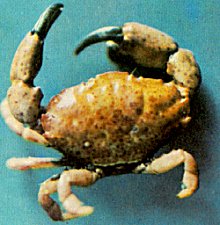 Synonyms:
Xantho rivulosus Risso 1816, Rathke, 1837; Xantho
hydrophilus Pesta, 1918; Xantho rivulosus Drach et
Forest, 1953; Xantho poressa Holthuis, 1954.
Synonyms:
Xantho rivulosus Risso 1816, Rathke, 1837; Xantho
hydrophilus Pesta, 1918; Xantho rivulosus Drach et
Forest, 1953; Xantho poressa Holthuis, 1954.Xantho poressa (Olivii, 1792)
 Synonyms:
Xantho rivulosus Risso 1816, Rathke, 1837; Xantho
hydrophilus Pesta, 1918; Xantho rivulosus Drach et
Forest, 1953; Xantho poressa Holthuis, 1954.
Synonyms:
Xantho rivulosus Risso 1816, Rathke, 1837; Xantho
hydrophilus Pesta, 1918; Xantho rivulosus Drach et
Forest, 1953; Xantho poressa Holthuis, 1954.
Common names: Rom: Crabul de tarm, camiorca; Russ: Ksanto; Turk: Yalama; Ukr: Ksanto.
Order (Scientific): DECAPODA.
Family (Scientific): XANTHIDAE.
Taxonomic descriptions: Front weld with the big article of antenna peduncle and separate to orbital-inner teeth.Chelipeds with black fingers; carpus with antero-inner teeth without tubercles or granulations. Dactylus with longitudinal margin; not completely closed. Claws short, thick, short - hairy to the adult. Size : length: 28 mm. Width: 20mm. Colour: variable - chestnut with red points. The fingers of chaela black. The eggs - lilac in colour.
 IUCN
Status:
IUCN
Status:
World level:
Black Sea Regional level: VU
Subregion level: VU
Distribution:
Habitats type, Critical habitats, Limiting factors: Stony grounds with mussels. Could be found often be to depths of 0.5-3 m but can reach to 20 m. Hard frost or storms. Its biotop of the stone was affected by the displacement of the shore during the arrangement of the cliffs of the sea side resorts or by the embankments and port rearrangements carried out on the coast.
Biology: Species with low prolificity. The high reproduction during July-August period. Female spawn 800 - 1400 eggs. Plankton larvae with 3 metamorphosis stages.
Population trends: During 1950-1970 very abundant in southern Romanian waters; also frequent until 1980, and rare at present. It had a narrower distribution area compared with 1980’s decade, in 1993 only 20 ind/m2 at 6 m depth on the southern Romanian littoral - Eforie South).
Threats: Pollution mainly from point sources, hypoxia; silt covering stony ground.
Conservation measures taken: Included in the Red Data Book of Ukraine, 1994.
Conservation measures proposed: Reduce microbial pollution, increase the protection of coastal waters against chemical and microbiological contamination.
References:
Compiled by: C.Dumitrache.